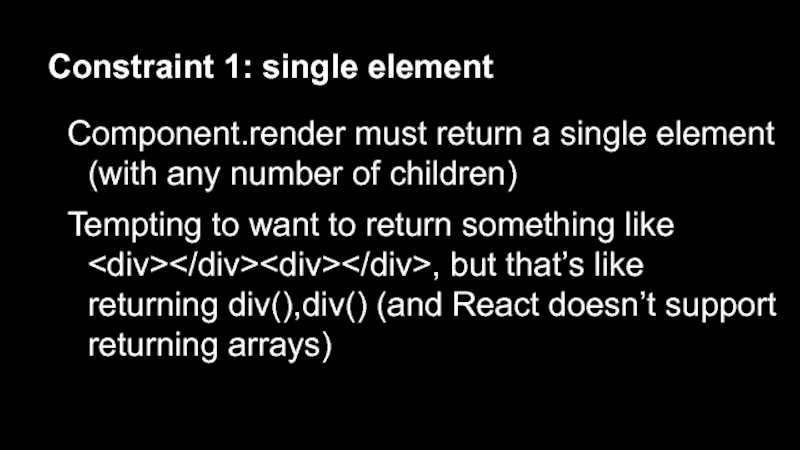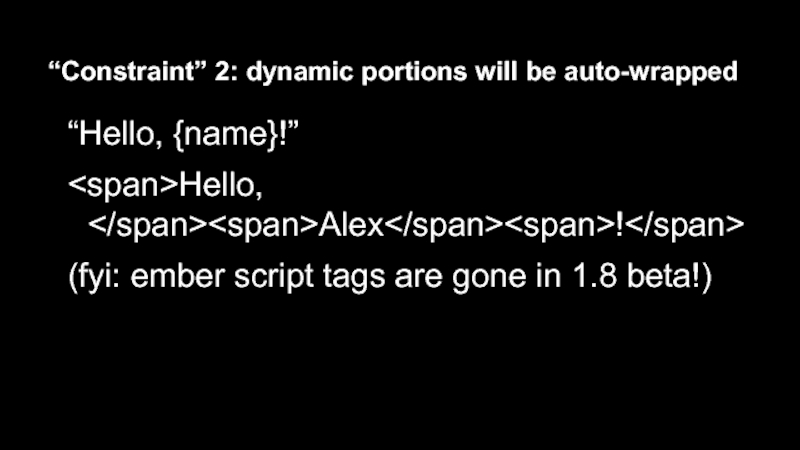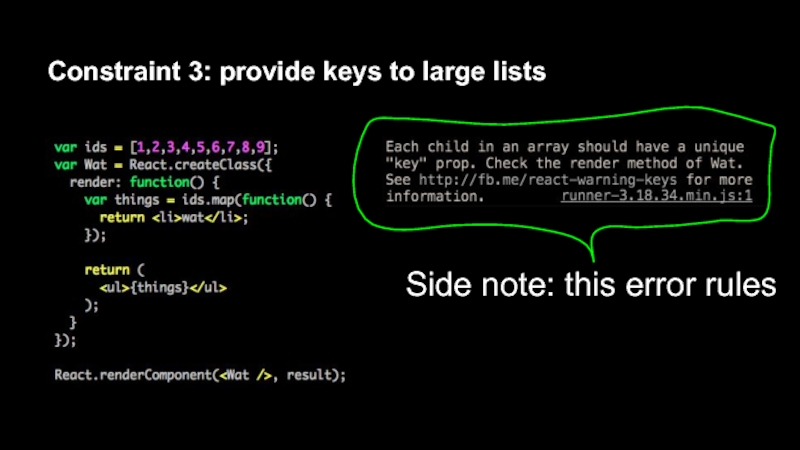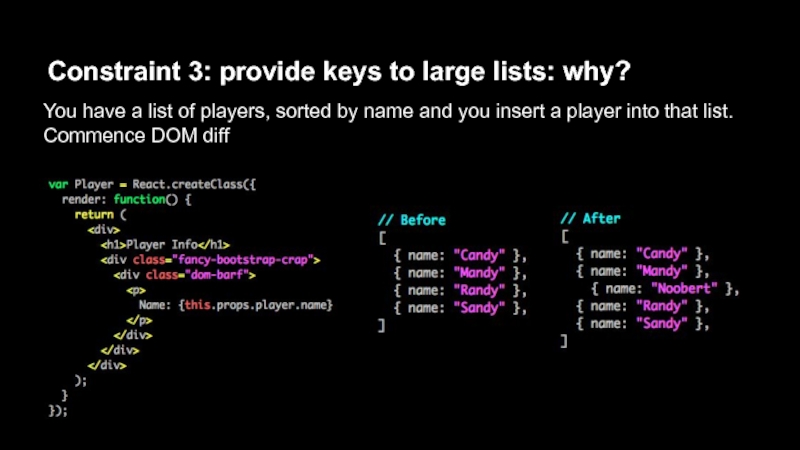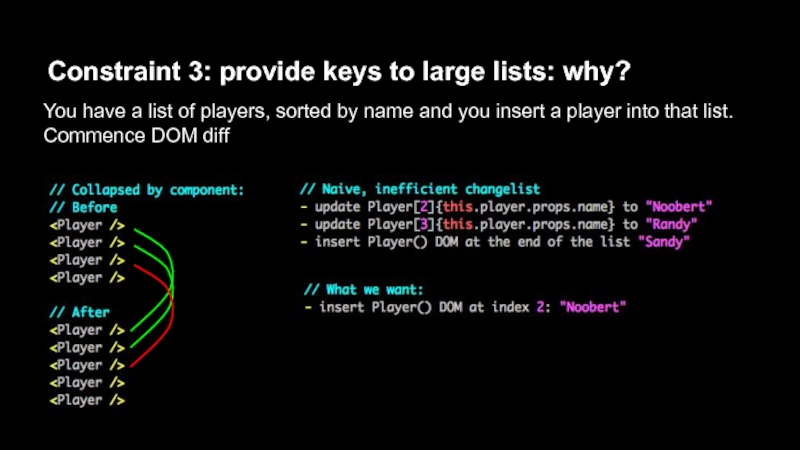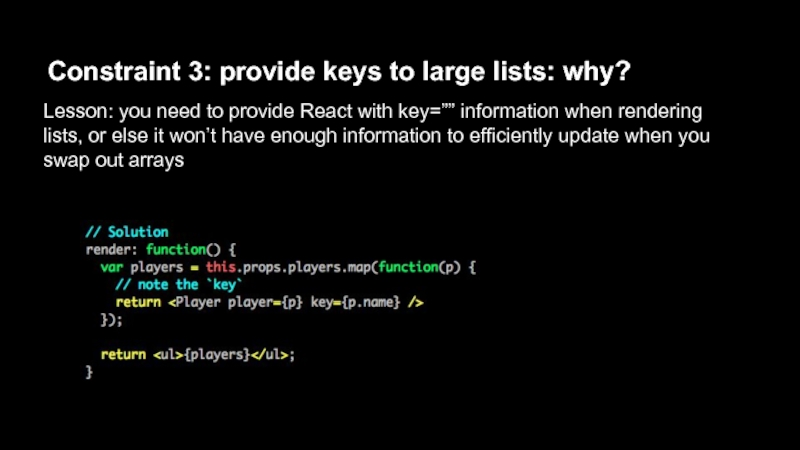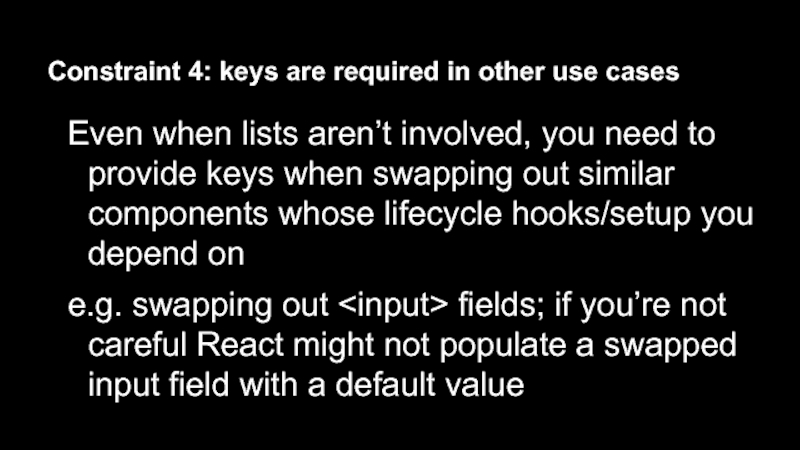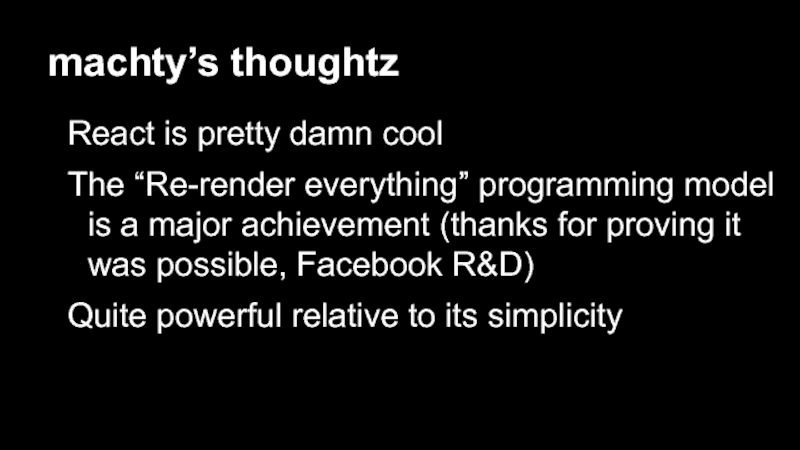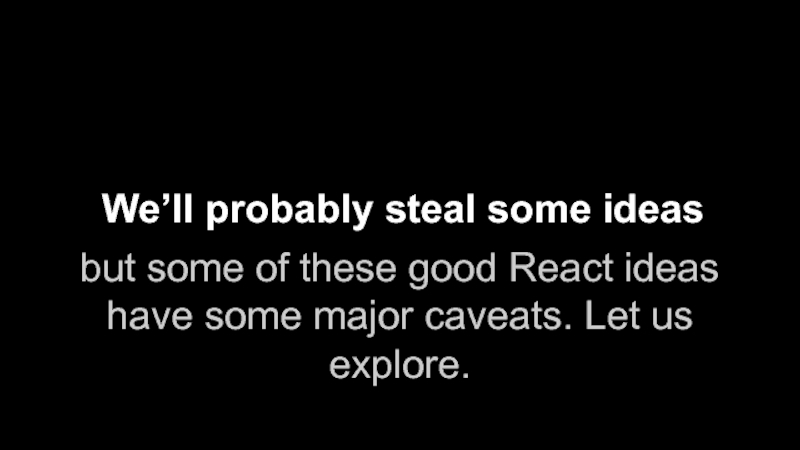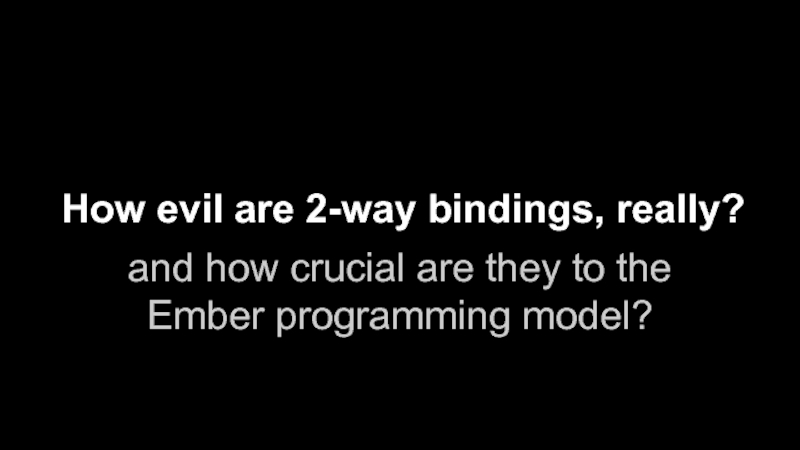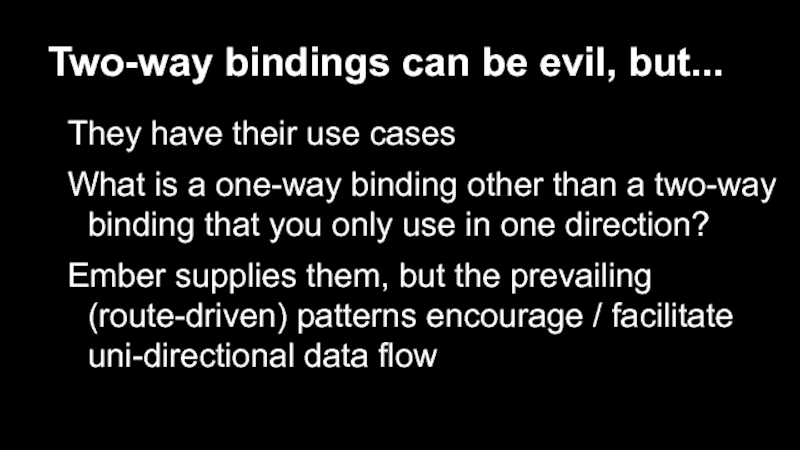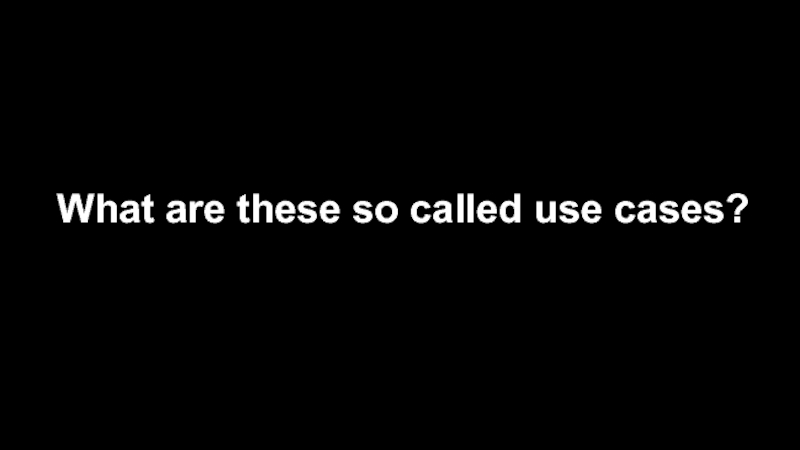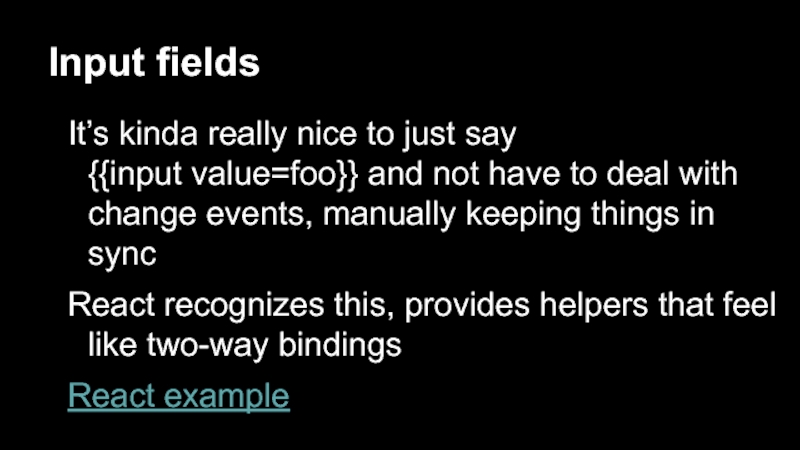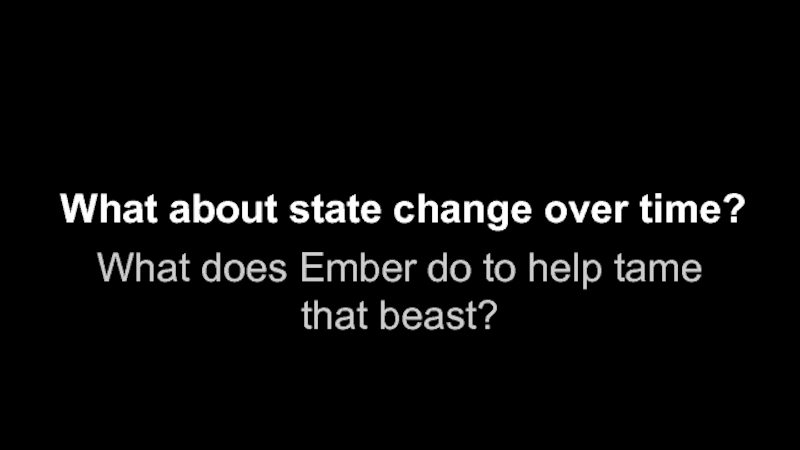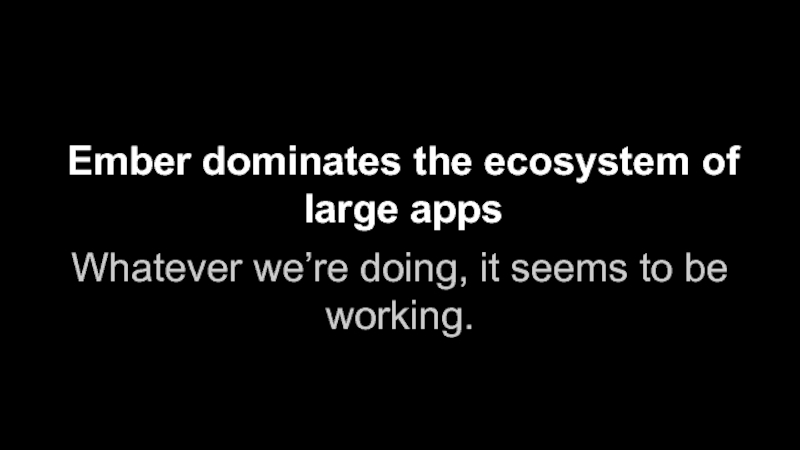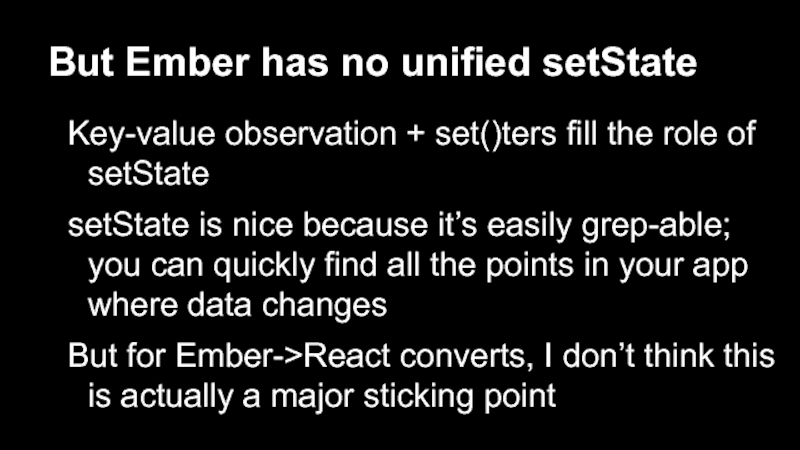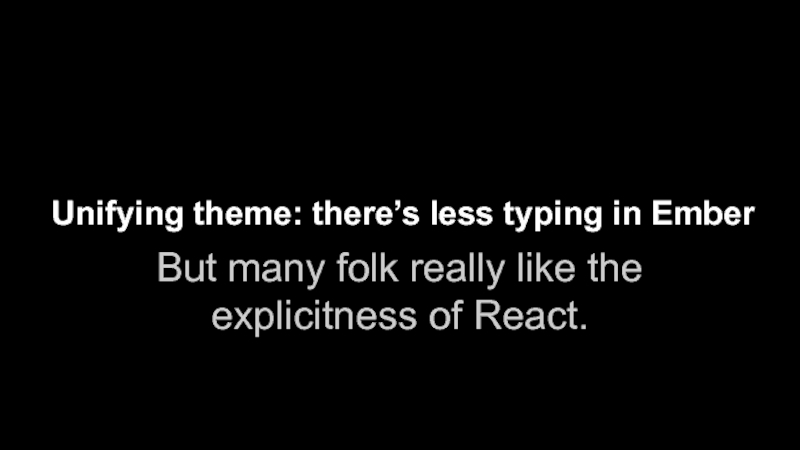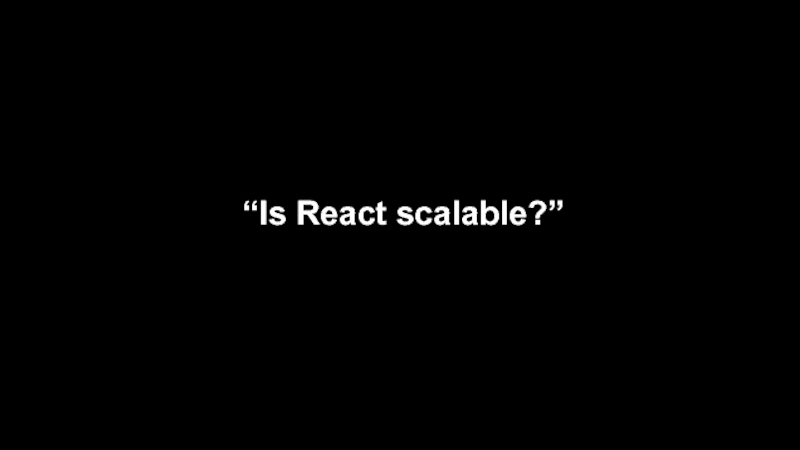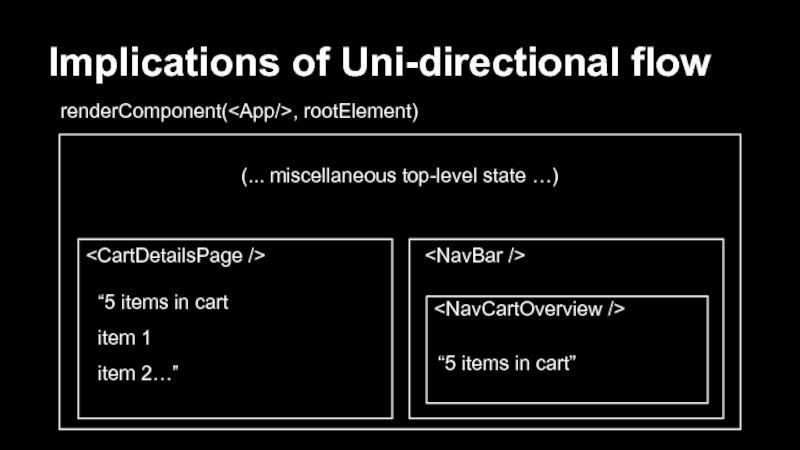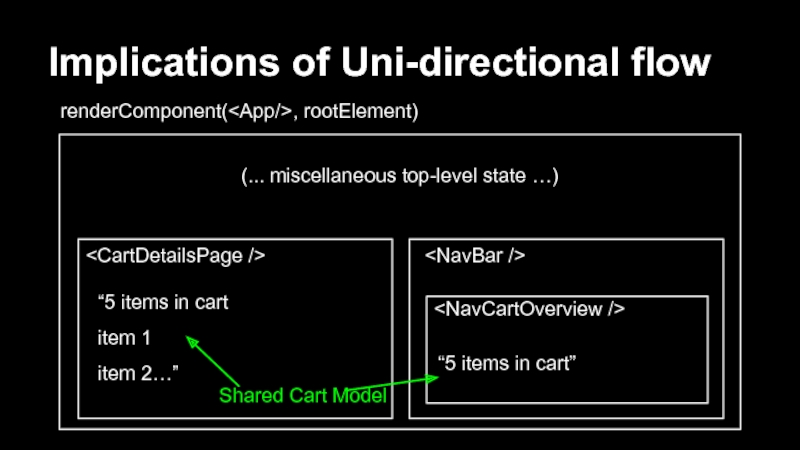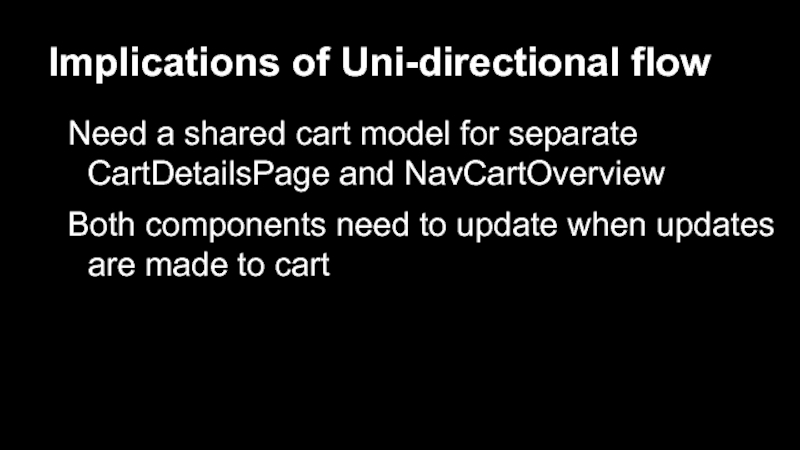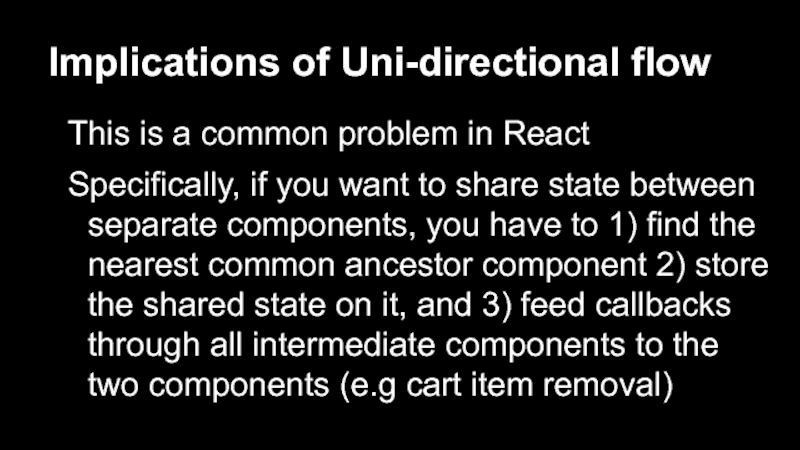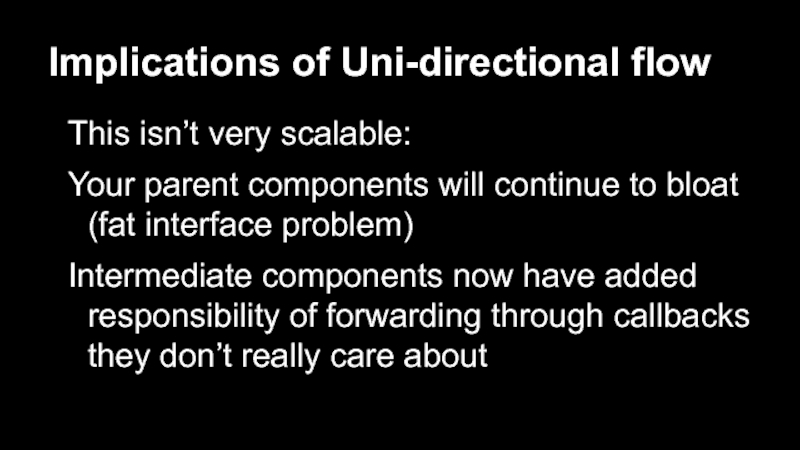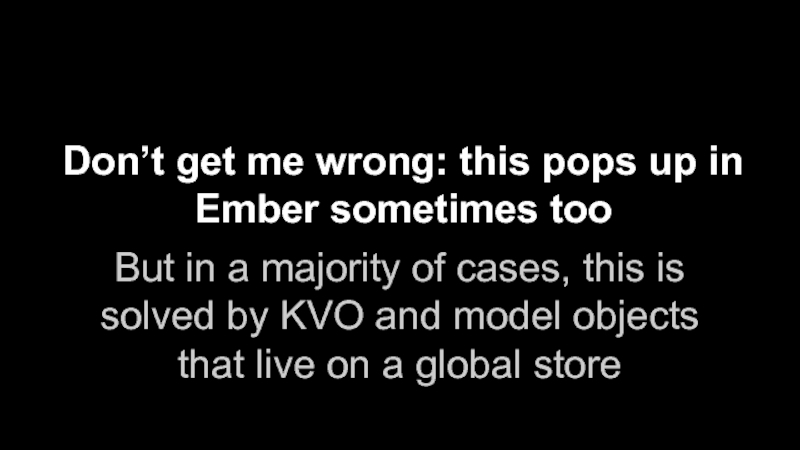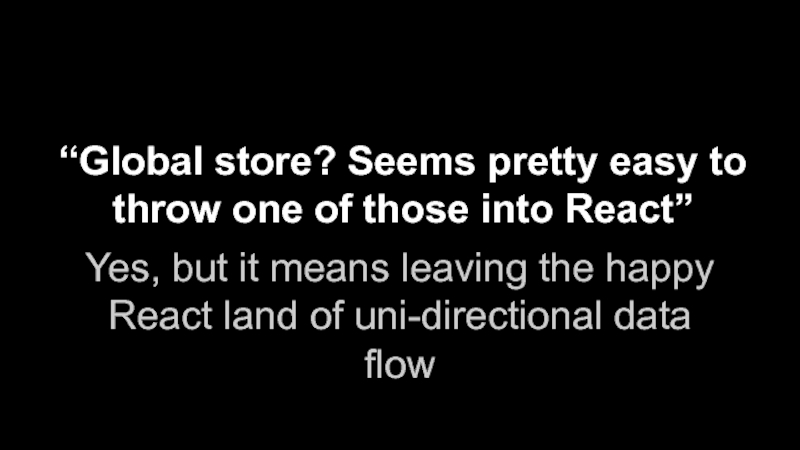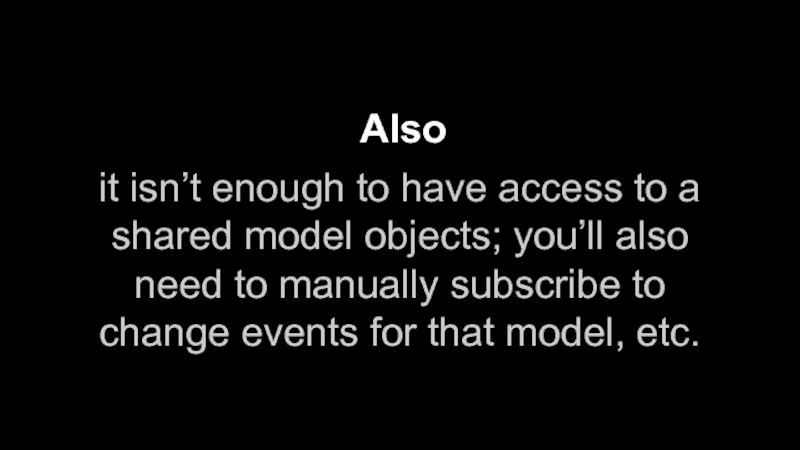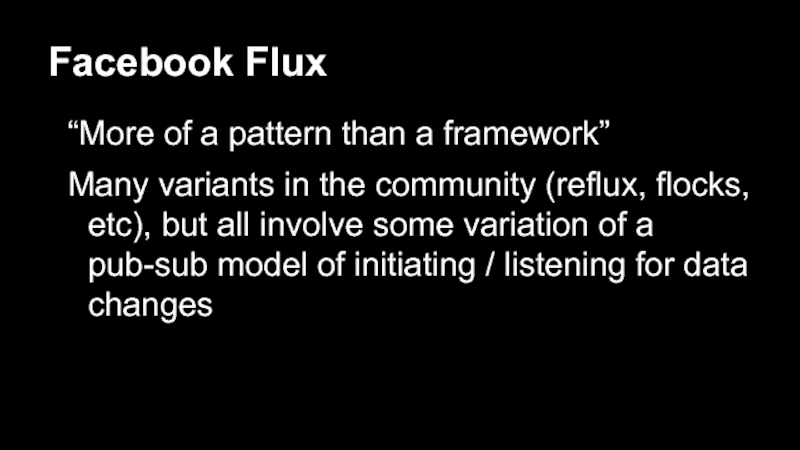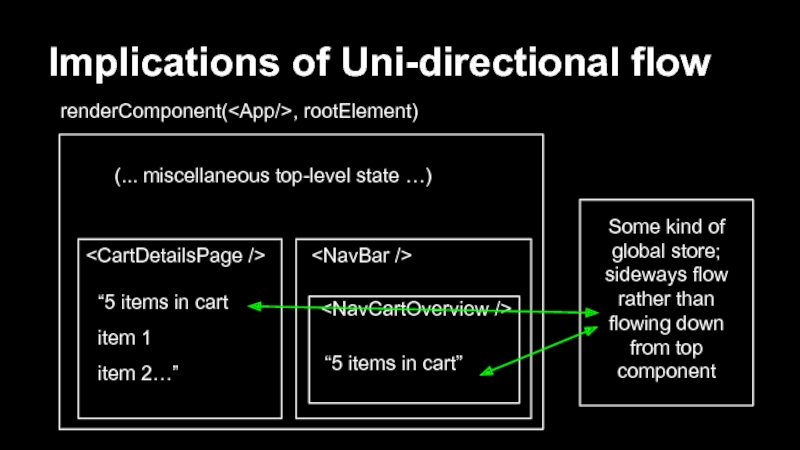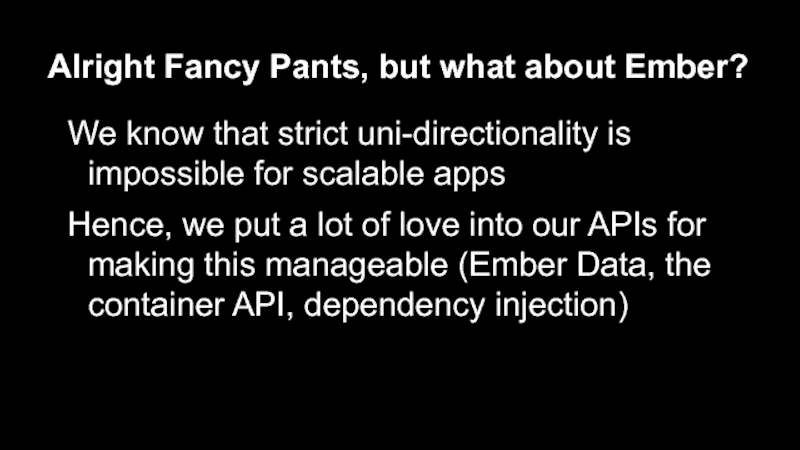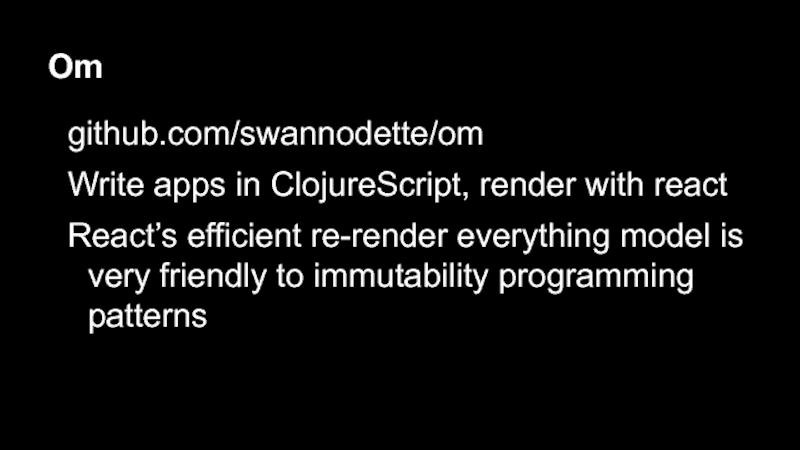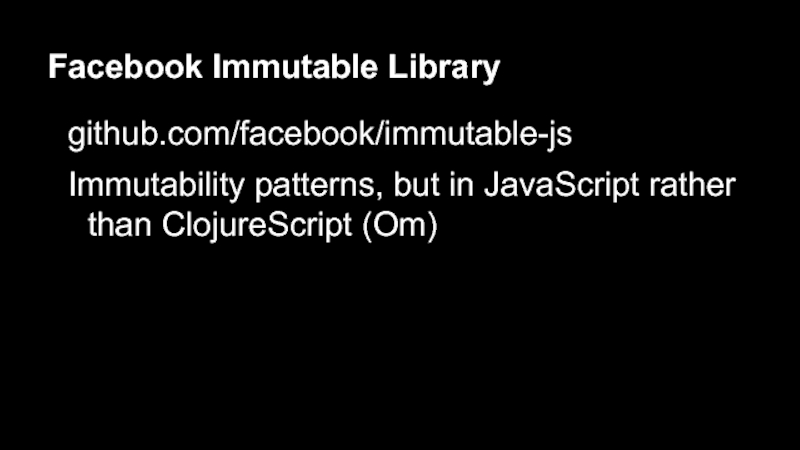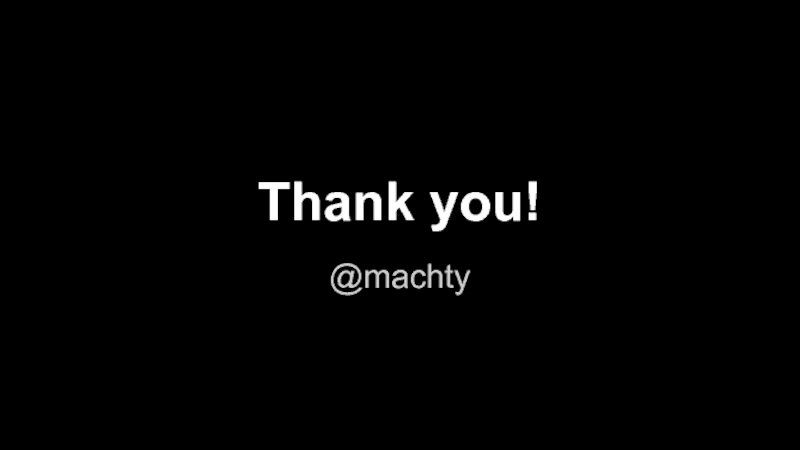Разделы презентаций
- Разное
- Английский язык
- Астрономия
- Алгебра
- Биология
- География
- Геометрия
- Детские презентации
- Информатика
- История
- Литература
- Математика
- Медицина
- Менеджмент
- Музыка
- МХК
- Немецкий язык
- ОБЖ
- Обществознание
- Окружающий мир
- Педагогика
- Русский язык
- Технология
- Физика
- Философия
- Химия
- Шаблоны, картинки для презентаций
- Экология
- Экономика
- Юриспруденция
Ember.setState(this.get(React))
Содержание
- 1. Ember.setState(this.get(React))
- 2. Who’s this guyAlex Matchneer@machtyEmber.js Core TeamExpressCheckoutApp.com
- 3. You may remember me from ng-embereño“This is
- 4. Слайд 4
- 5. The V in MVC… kindaReact.js
- 6. About ReactOpen-sourced by Facebook mid-2013Currently at version
- 7. So… what is React?Component-centric view layer...that is
- 8. Aren’t there like a million JavaScript view layers out there?So what?
- 9. But it’s important to understand the philosophy behind many of React’s design decisions.Yes.
- 10. Managing state is treacherousReact Postulate 1
- 11. State management is difficulte.g. which radio button
- 12. Two-way bindings are evilReact Postulate 2
- 13. Two Way Bindings are EvilTransparency: effects of
- 14. Cue poor man’s XKCD
- 15. Слайд 15
- 16. Слайд 16
- 17. Слайд 17
- 18. Слайд 18
- 19. Слайд 19
- 20. Two-way bindings are like Ice Nine.Read some Vonnegut if this makes no sense.In other words...
- 21. Data changing over time is the ultimate root of all evilReact Postulate 3
- 22. So how is React designed to deal with all of this awfulness?TL;DR: Everything is Difficult
- 23. Uni-directional Data Flow: State vs PropsComponents can
- 24. ...data needs to come back upward somehow, right?But wait...
- 25. what if a parent renders a child
- 26. CallbacksIn order for a child to notify
- 27. Yeah, naw, they’re just callbacks. They’re not
- 28. So what about state changes over time being the root of all evil?Cool
- 29. Слайд 29
- 30. Слайд 30
- 31. ...literally everything re-renders from that point downwardIn React, when you call setState...
- 32. Слайд 32
- 33. Слайд 33
- 34. We’re talking giant arrays of stuffOMG that sounds insane
- 35. Doesn’t that just kill performance?No.
- 36. Doesn’t mess up scrolling?No.
- 37. Doesn’t that mean needlessly tearing down and rebuilding DOM?No.
- 38. WTF?
- 39. VIRTUALDOM
- 40. Virtual DOMJavaScript representation of DOM nodes, totally
- 41. VIRTUALDOM DIFFING
- 42. Every time you call setState...A new virtual
- 43. HenceNo unnecessary/expensive teardown of DOM
- 44. HenceScrolling doesn’t break (any more than it might with fine-tuned, granular DOM manipulation)
- 45. But you still rebuild / recalculate large
- 46. What about diffing trees?Isn’t that O(n^3)?No, due
- 47. But first...
- 48. We have to talk about JSX
- 49. A preprocessor: XMLish syntax -> JavaScriptCompletely optionalIntended
- 50. JSX ExamplesJSXJavaScript
- 51. It’s all JavaScriptWe don’t need no templates
- 52. Templates often live in a separate file
- 53. Handlebars is our templating engineControllers or Components
- 54. There’s no “template context”The “context” (the data
- 55. React Example
- 56. React Example
- 57. React Example
- 58. React / JSX nicetiesMinimal syntactic sugar over
- 59. React / JSX drawbacksFlow control (if blocks,
- 60. React / JSX drawbacks: example
- 61. React / JSX drawbacks: example
- 62. React / JSX drawbacksEmber + Handlebars:Because Handlebars
- 63. So, DOM in JavaScript…?Seems like poor separation of concerns?
- 64. React authors argue the contrary:Given the extremely
- 65. HenceIn React, everything is a component.
- 66. OK, we get it.Time to pop() the stack, but I feel it’s worth mentioning:
- 67. If you’re going to hate on React for some reason, make it something other than JSX
- 68. stack.pop()[react, diffing heuristics, JSX]
- 69. stack.pop()[react, diffing heuristics]
- 70. We were talking about virtual DOM diffing
- 71. Constraint 1: single elementComponent.render must return a
- 72. “Constraint” 2: dynamic portions will be auto-wrapped“Hello,
- 73. Constraint 3: provide keys to large listsSide note: this error rules
- 74. Constraint 3: provide keys to large lists:
- 75. Constraint 3: provide keys to large lists:
- 76. Constraint 3: provide keys to large lists:
- 77. Constraint 4: keys are required in other
- 78. That’s about it for specificsAt this point
- 79. So what do I think?I thought you’d never ask
- 80. machty’s thoughtzReact is pretty damn coolThe “Re-render
- 81. machty’s thoughtzReact Components are incredibly flexible; because
- 82. If you love it so much why don’t yousteal all of its good ideas?
- 83. We’ll probably steal some ideasbut some of
- 84. So, why does Emberprovide 2-way bindings if they’re so dangerous?
- 85. How evil are 2-way bindings, really?and how crucial are they to the Ember programming model?
- 86. Two-way bindings can be evil, but...They have
- 87. What are these so called use cases?
- 88. Input fieldsIt’s kinda really nice to just
- 89. What about state change over time?What does Ember do to help tame that beast?
- 90. First off, let’s just acknowledge thatwe have clearly tamed that beast
- 91. Ember dominates the ecosystem of large appsWhatever we’re doing, it seems to be working.
- 92. But specifically: Ember already has uni-directional data
- 93. But Ember has no unified setStateKey-value observation
- 94. Unifying theme: there’s less typing in EmberBut many folk really like the explicitness of React.
- 95. “Is React scalable?”
- 96. “Yes, you dummy, obviously it’s scalable if
- 97. Implications of Uni-directional flowrenderComponent(, rootElement)(... miscellaneous top-level
- 98. Implications of Uni-directional flowrenderComponent(, rootElement)(... miscellaneous top-level
- 99. Need a shared cart model for separate
- 100. This is a common problem in ReactSpecifically,
- 101. This isn’t very scalable: Your parent components
- 102. Don’t get me wrong: this pops up
- 103. “Global store? Seems pretty easy to throw
- 104. Alsoit isn’t enough to have access to
- 105. Enter FluxReact’s escape hatch
- 106. “More of a pattern than a framework”Many
- 107. Not super important to understand a lot
- 108. Implications of Uni-directional flowrenderComponent(, rootElement)(... miscellaneous top-level
- 109. We know that strict uni-directionality is impossible
- 110. Alright, wrap it upI have to mention some cool projects
- 111. github.com/rackt/react-routerRyan Florence’s and Michael Jackson’s brainchildHeavily inspired
- 112. github.com/swannodette/omWrite apps in ClojureScript, render with reactReact’s
- 113. github.com/facebook/immutable-jsImmutability patterns, but in JavaScript rather than ClojureScript (Om)Facebook Immutable Library
- 114. React is awesomeTry it outDon’t be surprised if Ember adopts DOM-diffingFinal Thoughts
- 115. @machtyThank you!
- 116. Скачать презентанцию
Слайды и текст этой презентации
Слайд 3You may remember me from ng-embereño
“This is the only intelligent
comparison I have seen of Ember & Angular”
UserСлайд 6About React
Open-sourced by Facebook mid-2013
Currently at version 0.11.1
Drives many widgets
in Facebook and much (all?) of the Instagram web experience
GitHub’s
Atom text editor uses itDefinitely some outspoken Ember->React converts
Слайд 7So… what is React?
Component-centric view layer
...that is highly performant
…that encourages
uni-directional data flow and facilitates many lovely functional patterns
Слайд 11State management is difficult
e.g. which radio button is selected, which
user is logged in, which article are we looking at,
whether a widget is currently being draggedСлайд 13Two Way Bindings are Evil
Transparency: effects of a code change
are limited/local, or at least easy to reason about
Also a
useful concept regarding state changeTwo-way bindings open Pandora’s box:
No easy way of knowing how far-reaching a change in the reverse direction is going to be
Слайд 20Two-way bindings are like Ice Nine.
Read some Vonnegut if this
makes no sense.
In other words...
Слайд 23Uni-directional Data Flow: State vs Props
Components can either be passed
data (props), or materialize their own state and manage it
over time (state)Passed-in props are immutable (no two-way binding, remember?)
Components explicitly modify their state via this.setState
Слайд 26Callbacks
In order for a child to notify its parent of
a state change, a parent must pass the child a
callback as one of its properties(I’ll talk about alternatives to this later)
Слайд 27Yeah, naw, they’re just callbacks. They’re not events that keep
bubbling or anything like that.
Kinda like actions in Ember, right?
Слайд 31...literally everything re-renders from that point downward
In React, when you
call setState...
Слайд 40Virtual DOM
JavaScript representation of DOM nodes, totally separate from the
browser’s slow JavaScript/C++ DOM API
Makes server-side rendering possible (because
Node doesn’t need to have a real DOM API)And most importantly...
Слайд 42Every time you call setState...
A new virtual DOM tree is
generated
New tree is diffed against old…
...producing a minimum set of
changes to be performed on real DOM to bring it up to dateСлайд 44Hence
Scrolling doesn’t break (any more than it might with fine-tuned,
granular DOM manipulation)
Слайд 45But you still rebuild / recalculate large objects / arrays?
Turns
out JavaScript is fast, and that that part is rarely
the bottleneckСлайд 46What about diffing trees?
Isn’t that O(n^3)?
No, due to heuristics based
on how you’ve built up your tree of components.
Слайд 49A preprocessor: XMLish syntax -> JavaScript
Completely optional
Intended to make more
sense to designers (and anyone more comfortable working with HTML,
though it is not exactly HTML)JSX is
Слайд 52Templates often live in a separate file (e.g. .hbs)
Contain static
and dynamic portions, e.g. “some text” vs “some {{value}}”
Dynamic portions
“filled in” by whatever template context you pass inIt’s up to JavaScript portion of app to build up that context and expose it to the template
Templates
Слайд 53Handlebars is our templating engine
Controllers or Components are template contexts
that fill in the dynamic bits
Helpers aside, it’s pretty difficult
/ often private API to do lots of DOM rendering in JavaScriptTemplates/rendering in Ember
Слайд 54There’s no “template context”
The “context” (the data you have access
to while rendering DOM) is literally everything available in the
render function, and whatever it closes over...it’s just JavaScript after all
Rendering in React
Слайд 58React / JSX niceties
Minimal syntactic sugar over JavaScript, as opposed
to new syntax/language
No need to re-implement features that already exist
in JavaScript in your templating language of choicee.g. ES6 / require imports
No template context abstraction
Слайд 59React / JSX drawbacks
Flow control (if blocks, loops), or anything
involving lambdas, are awkward
Often they need to be kept visually
separate from the rest of your render codeСлайд 62React / JSX drawbacks
Ember + Handlebars:
Because Handlebars isn’t “just JavaScript”,
its syntax can stay presentation-focused; e.g. you don’t have to
distinguish between lambdas and valueslambda
Слайд 64React authors argue the contrary:
Given the extremely tight coupling between
the template and it’s context (a controller/component), the concerns are
the same, and splitting the DOM into a template is an arbitrary separation of technologies rather than a legit separation of concerns.Слайд 70We were talking about virtual DOM diffing constraints and heuristics
There
are some rules to abide by, now that we understand
JSX.Слайд 71Constraint 1: single element
Component.render must return a single element (with
any number of children)
Tempting to want to return something like
, but that’s like returning div(),div() (and React doesn’t support returning arrays)Слайд 72“Constraint” 2: dynamic portions will be auto-wrapped
“Hello, {name}!”
Hello, Alex!
(fyi: ember
script tags are gone in 1.8 beta!)
Слайд 74Constraint 3: provide keys to large lists: why?
You have a
list of players, sorted by name and you insert a
player into that list. Commence DOM diffСлайд 75Constraint 3: provide keys to large lists: why?
You have a
list of players, sorted by name and you insert a
player into that list. Commence DOM diffСлайд 76Constraint 3: provide keys to large lists: why?
Lesson: you need
to provide React with key=”” information when rendering lists, or
else it won’t have enough information to efficiently update when you swap out arraysСлайд 77Constraint 4: keys are required in other use cases
Even when
lists aren’t involved, you need to provide keys when swapping
out similar components whose lifecycle hooks/setup you depend one.g. swapping out fields; if you’re not careful React might not populate a swapped input field with a default value
Слайд 78That’s about it for specifics
At this point you should hopefully
decently grok the basics of React architecture
Слайд 80machty’s thoughtz
React is pretty damn cool
The “Re-render everything” programming model
is a major achievement (thanks for proving it was possible,
Facebook R&D)Quite powerful relative to its simplicity
Слайд 81machty’s thoughtz
React Components are incredibly flexible; because they take you
so much closer to the DOM, there are many widgets
that are just straight up easier to write in React than EmberСлайд 83We’ll probably steal some ideas
but some of these good React
ideas have some major caveats. Let us explore.
Слайд 85How evil are 2-way bindings, really?
and how crucial are they
to the Ember programming model?
Слайд 86Two-way bindings can be evil, but...
They have their use cases
What
is a one-way binding other than a two-way binding that
you only use in one direction?Ember supplies them, but the prevailing (route-driven) patterns encourage / facilitate uni-directional data flow
Слайд 88Input fields
It’s kinda really nice to just say
{{input value=foo}}
and not have to deal with change events, manually keeping
things in syncReact recognizes this, provides helpers that feel like two-way bindings
React example
Слайд 92But specifically: Ember already has uni-directional data flow
and our bindings
are live, so when upstream data changes, downstream changes too
Слайд 93But Ember has no unified setState
Key-value observation + set()ters fill
the role of setState
setState is nice because it’s easily grep-able;
you can quickly find all the points in your app where data changesBut for Ember->React converts, I don’t think this is actually a major sticking point
Слайд 94Unifying theme: there’s less typing in Ember
But many folk really
like the explicitness of React.
Слайд 96“Yes, you dummy, obviously it’s scalable if Facebook uses it.”
but
actually, it doesn’t take very long before you need to
expand beyond the patterns built into ReactСлайд 97Implications of Uni-directional flow
renderComponent(, rootElement)
(... miscellaneous top-level state …)
/>
“5 items in cart
item 1
item 2…”
“5 items in cart”
Слайд 98Implications of Uni-directional flow
renderComponent(, rootElement)
(... miscellaneous top-level state …)
/>
“5 items in cart
item 1
item 2…”
“5 items in cart”
Shared
Cart ModelСлайд 99Need a shared cart model for separate CartDetailsPage and NavCartOverview
Both
components need to update when updates are made to cart
Implications
of Uni-directional flowСлайд 100This is a common problem in React
Specifically, if you want
to share state between separate components, you have to 1)
find the nearest common ancestor component 2) store the shared state on it, and 3) feed callbacks through all intermediate components to the two components (e.g cart item removal)Implications of Uni-directional flow
Слайд 101This isn’t very scalable:
Your parent components will continue to
bloat (fat interface problem)
Intermediate components now have added responsibility of
forwarding through callbacks they don’t really care aboutImplications of Uni-directional flow
Слайд 102Don’t get me wrong: this pops up in Ember sometimes
too
But in a majority of cases, this is solved by
KVO and model objects that live on a global storeСлайд 103“Global store? Seems pretty easy to throw one of those
into React”
Yes, but it means leaving the happy React land
of uni-directional data flowСлайд 104Also
it isn’t enough to have access to a shared model
objects; you’ll also need to manually subscribe to change events
for that model, etc.Слайд 106“More of a pattern than a framework”
Many variants in the
community (reflux, flocks, etc), but all involve some variation of
a pub-sub model of initiating / listening for data changesFacebook Flux
Слайд 107Not super important to understand a lot of the details
(they also vary)
The key point is that you very quickly
get to a point that you ditch the unidirectional data flow at the React component level and start stashing state in a sideways, global mannerFacebook Flux
Слайд 108Implications of Uni-directional flow
renderComponent(, rootElement)
(... miscellaneous top-level state …)
/>
“5 items in cart
item 1
item 2…”
“5 items in cart”
Some
kind of global store; sideways flow rather than flowing down from top componentСлайд 109We know that strict uni-directionality is impossible for scalable apps
Hence,
we put a lot of love into our APIs for
making this manageable (Ember Data, the container API, dependency injection)Alright Fancy Pants, but what about Ember?
Слайд 111github.com/rackt/react-router
Ryan Florence’s and Michael Jackson’s brainchild
Heavily inspired by Ember router
Still
some churn, corner cases, gotchas, but extremely well done, and
feels very at home in React yet familiar to Ember devsReact Router (formally react-nested-router)




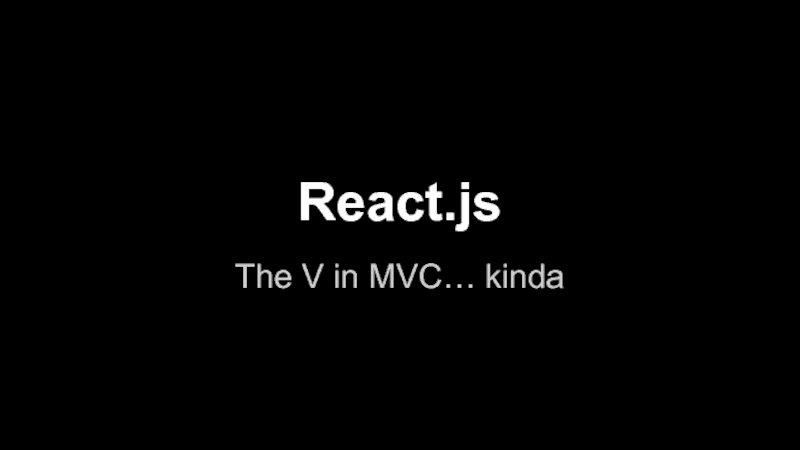
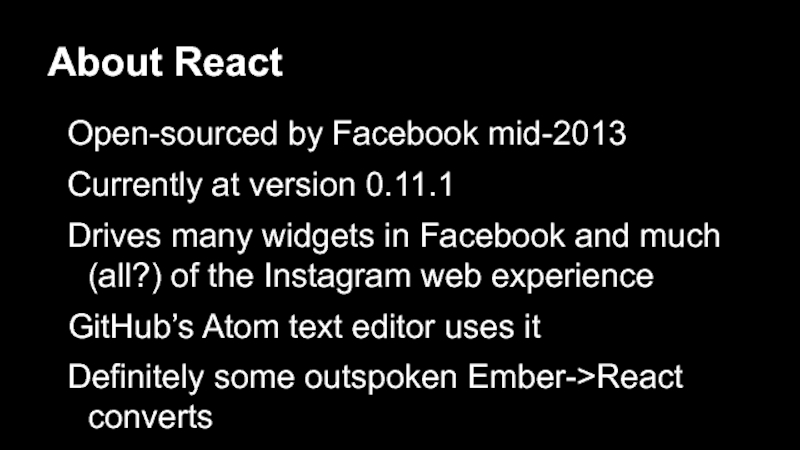



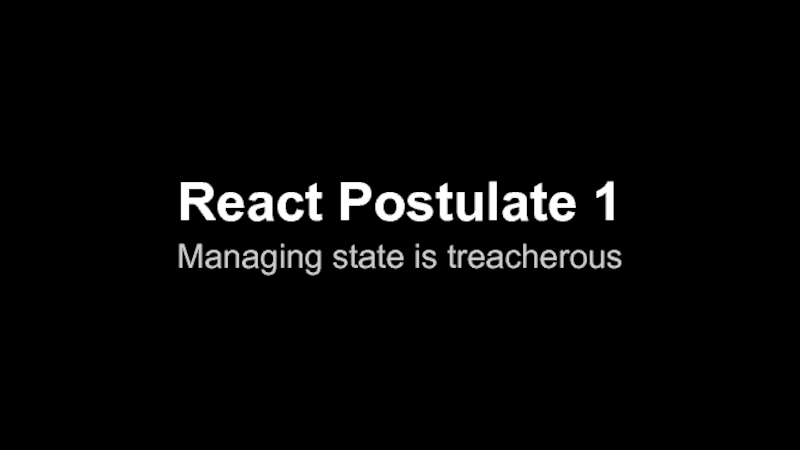
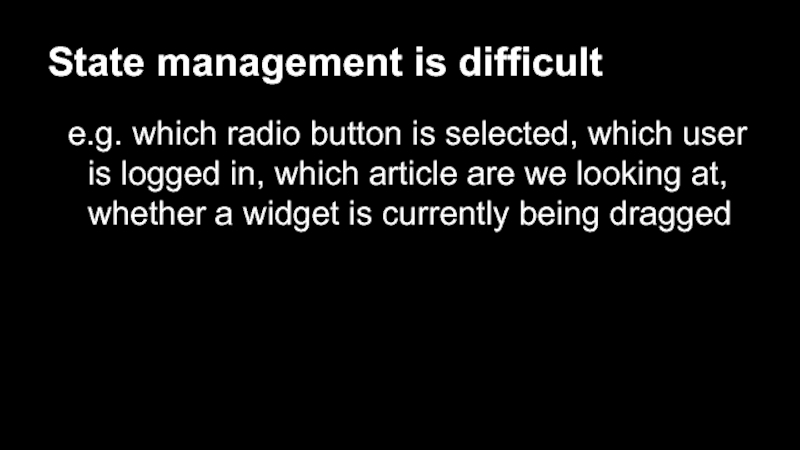
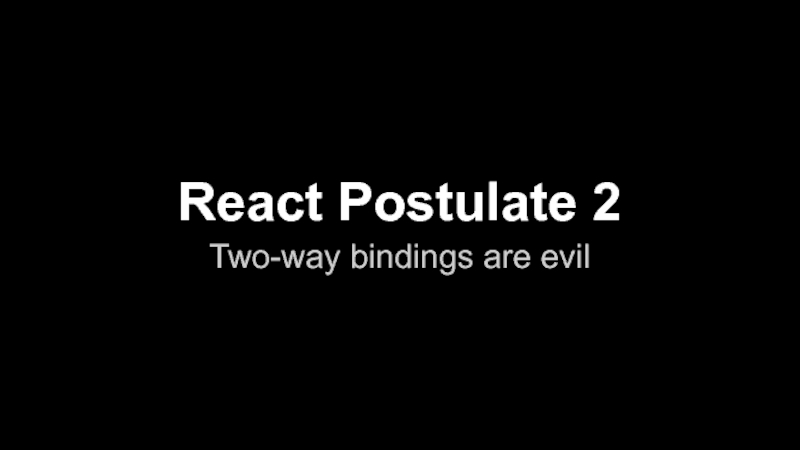
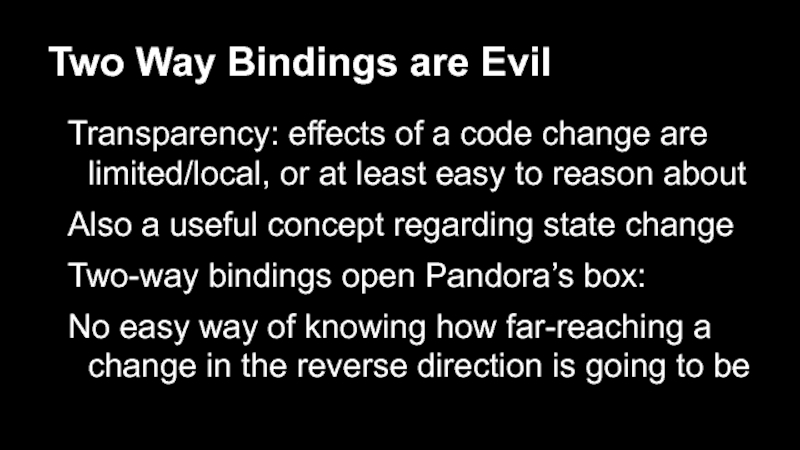







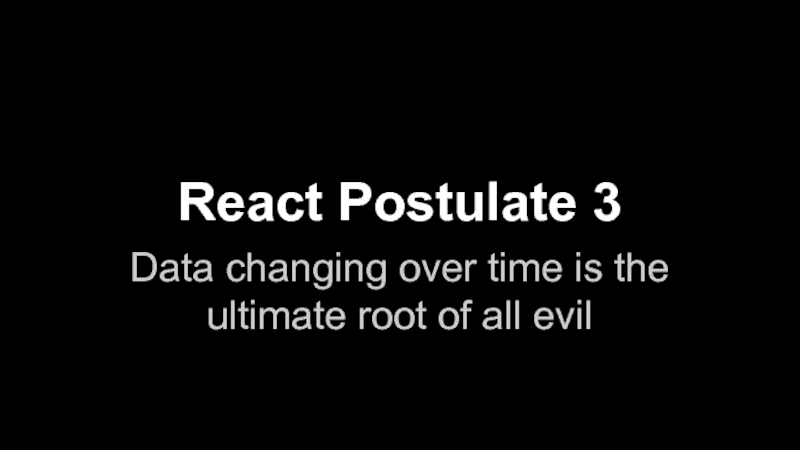



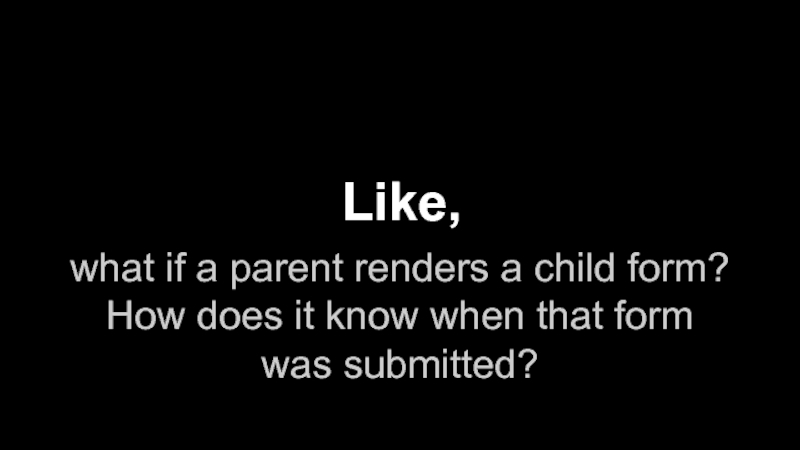
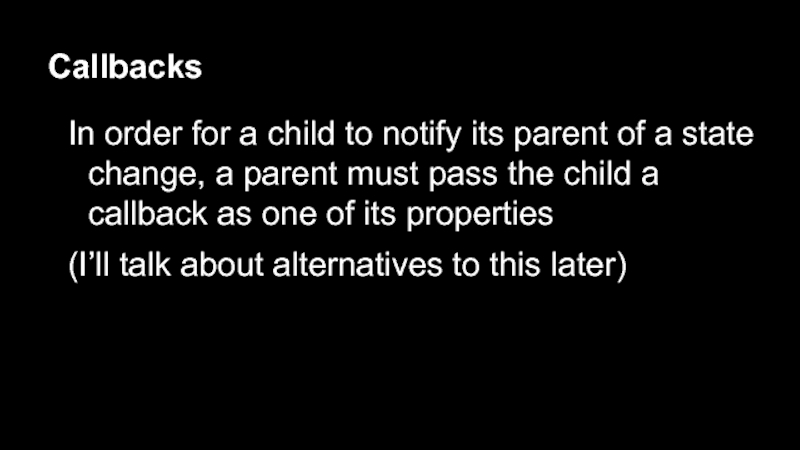
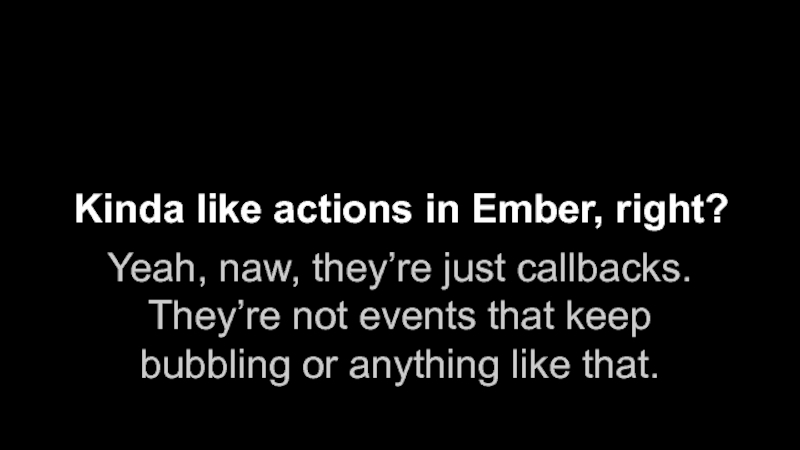
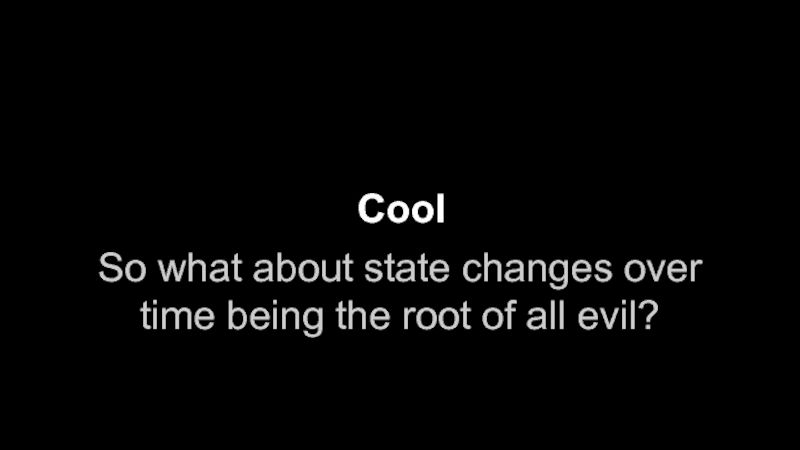


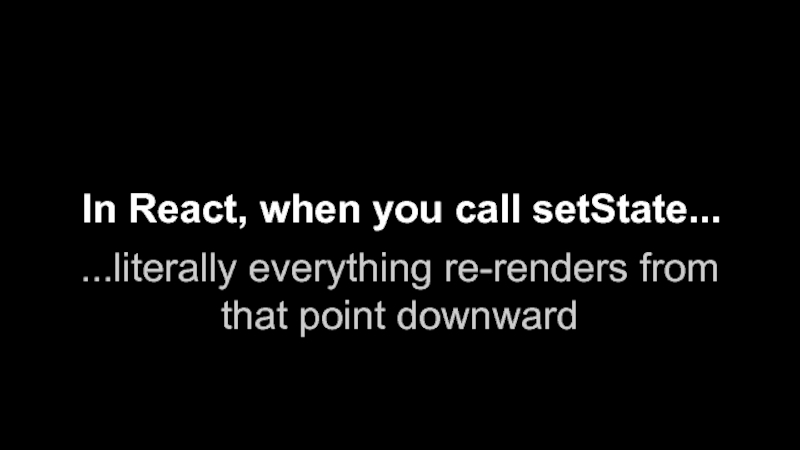










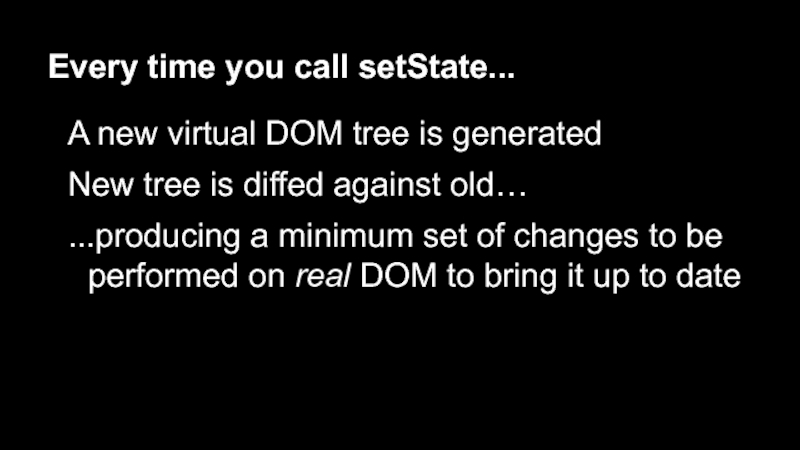



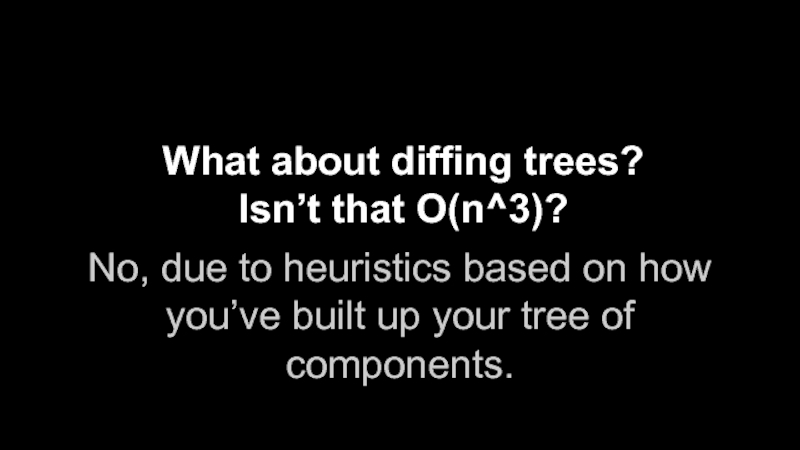


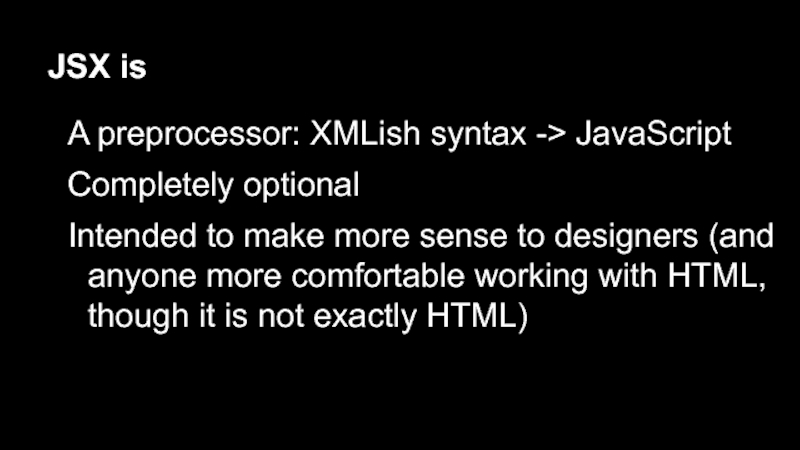
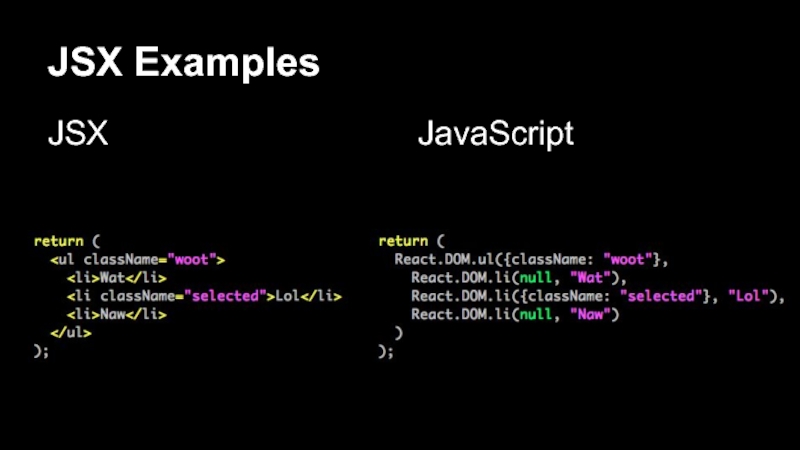

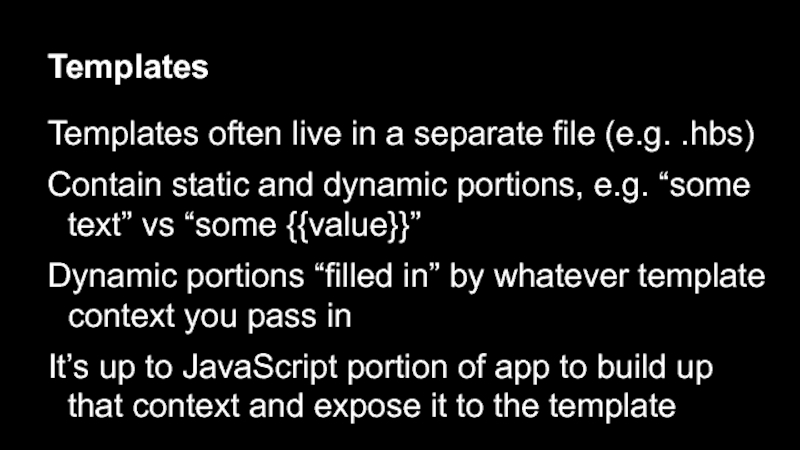


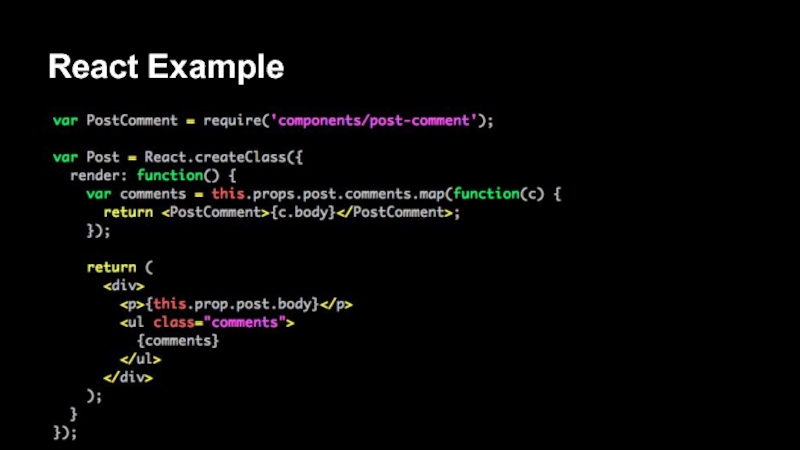
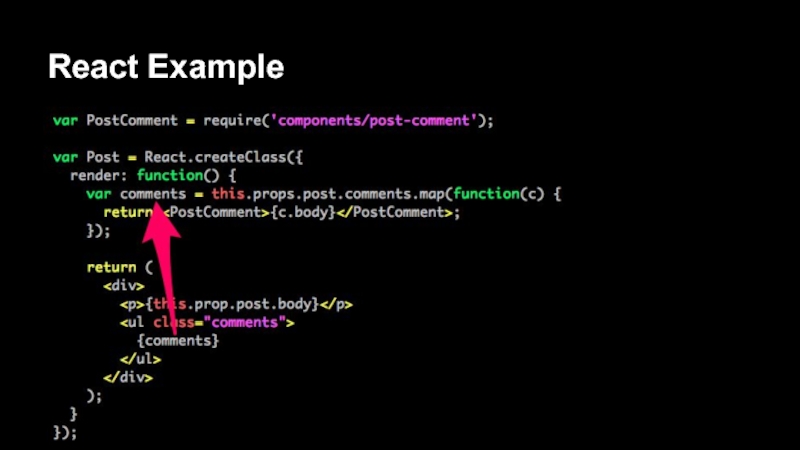
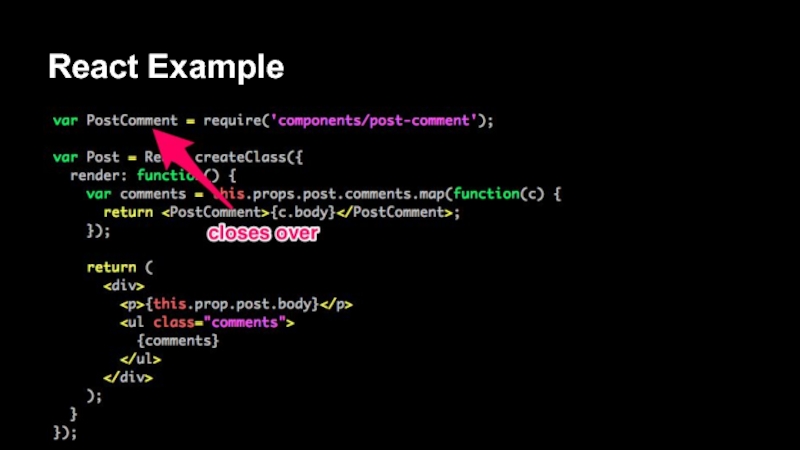
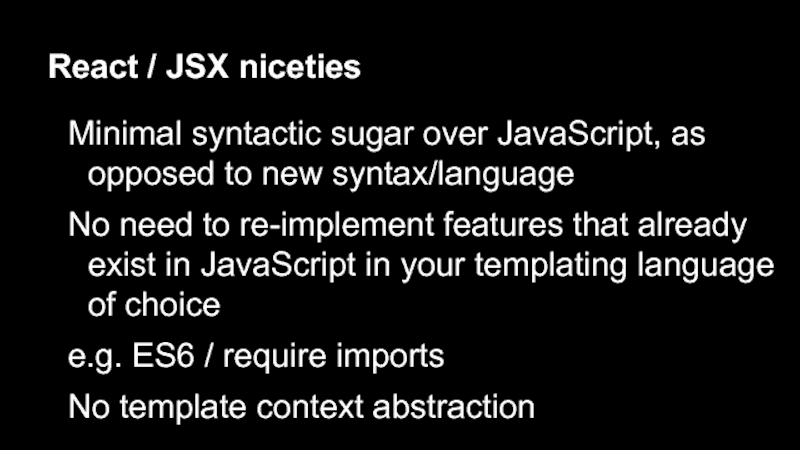
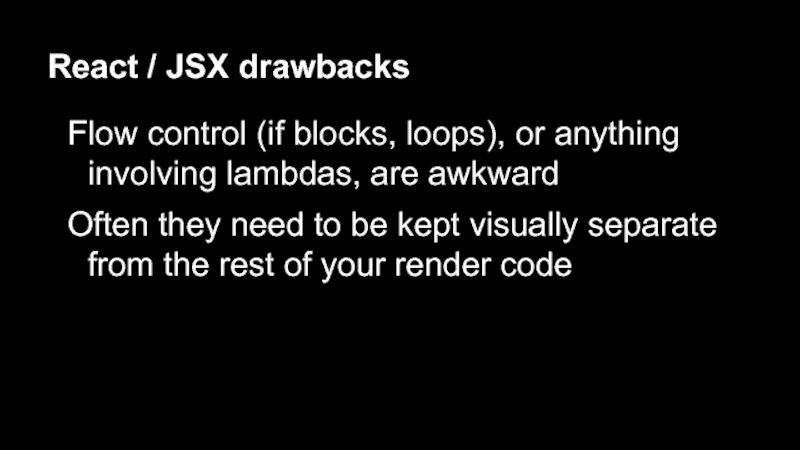
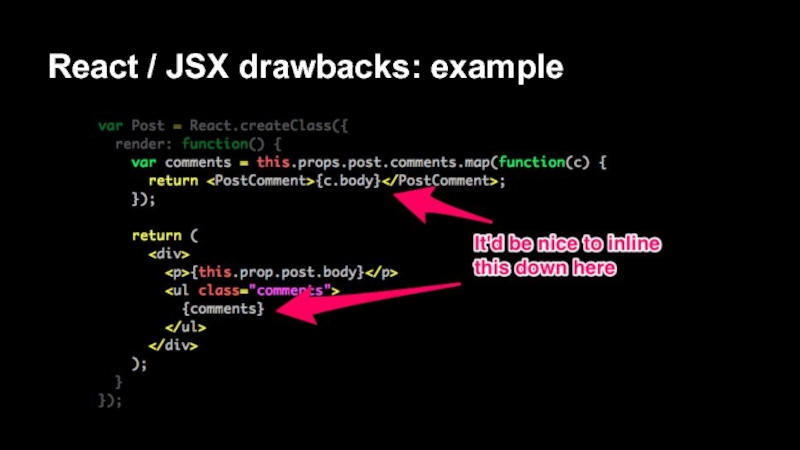
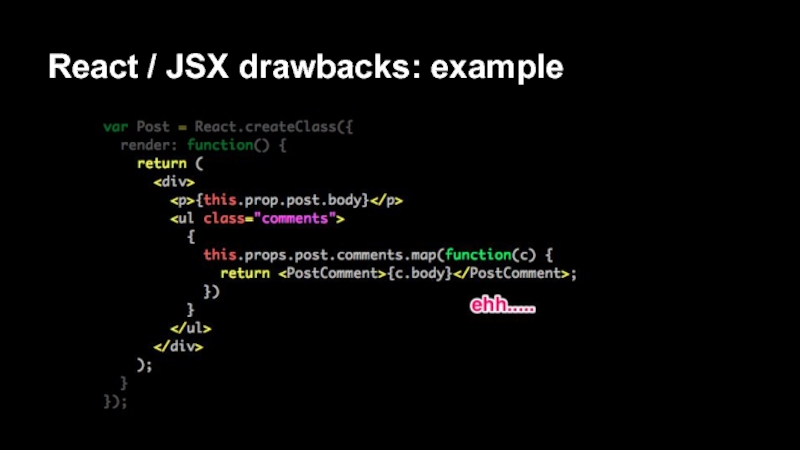
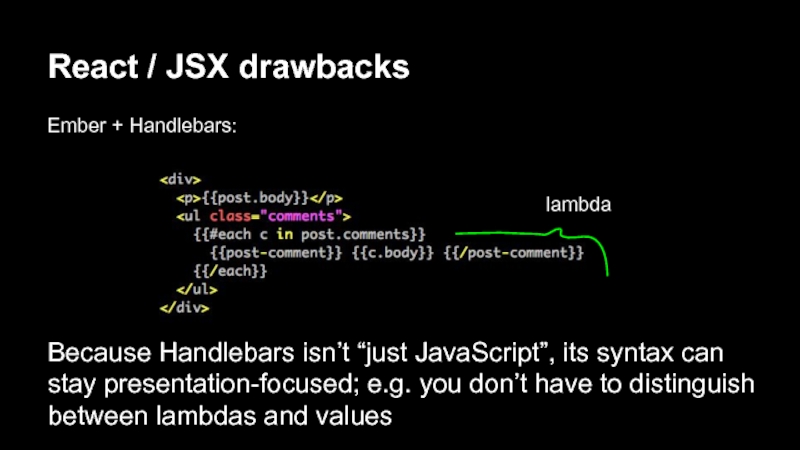
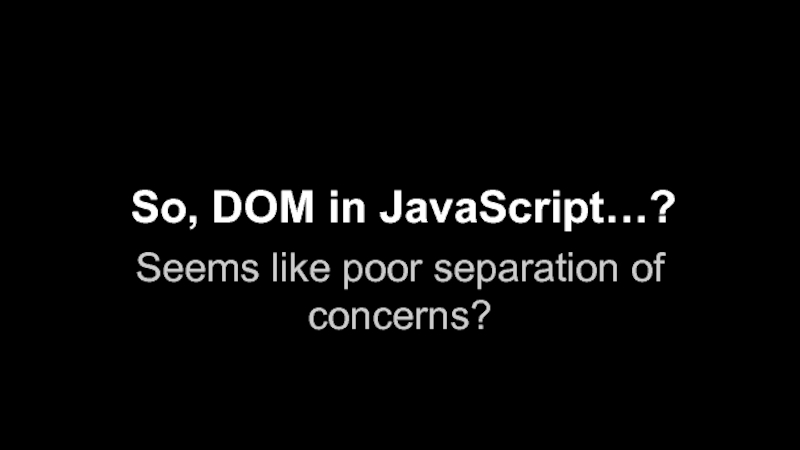
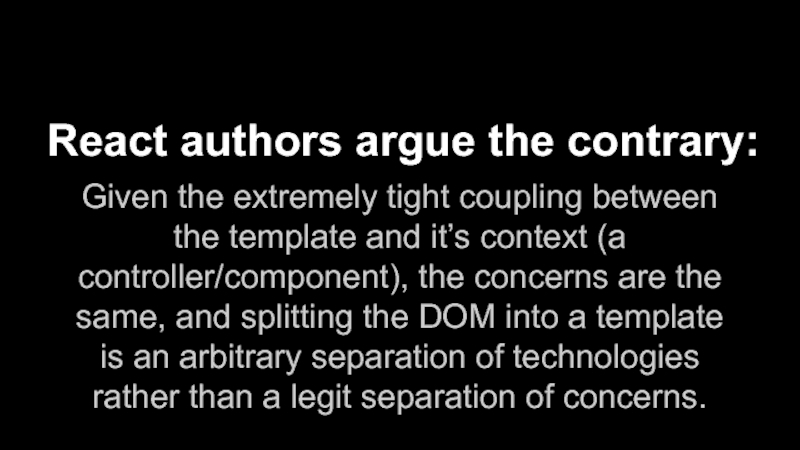
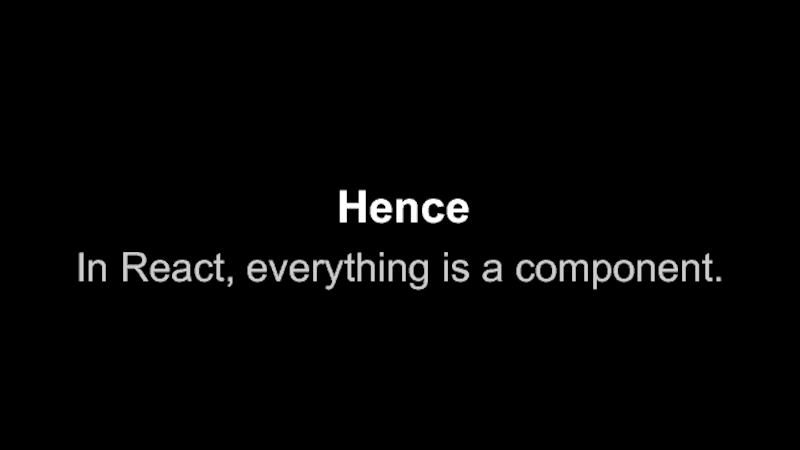
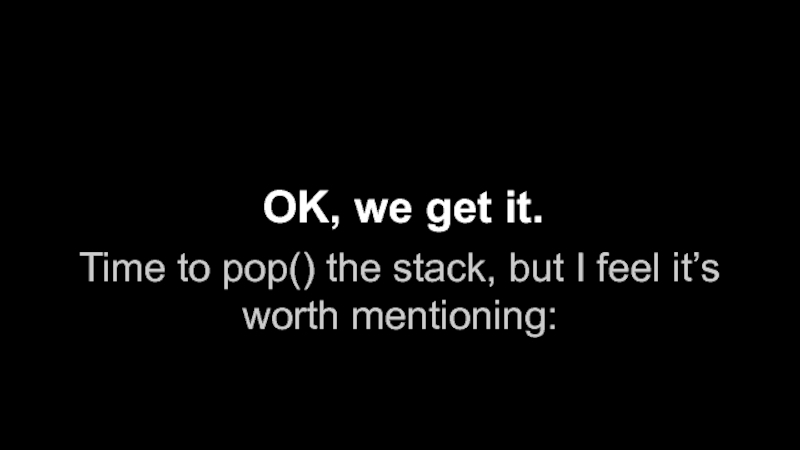

![Ember.setState(this.get(React)) stack.pop()[react, diffing heuristics, JSX] stack.pop()[react, diffing heuristics, JSX]](/img/thumbs/3c1bc1fdd281e65240d3b8606fc1ab0e-800x.jpg)
![Ember.setState(this.get(React)) stack.pop()[react, diffing heuristics] stack.pop()[react, diffing heuristics]](/img/thumbs/eee74b373466a9d9f29d6716d6e7a769-800x.jpg)

